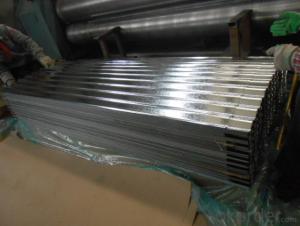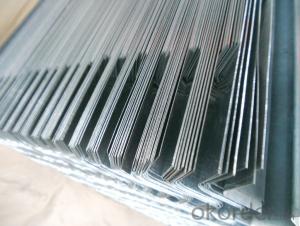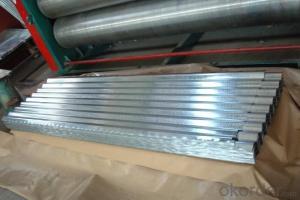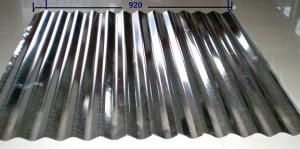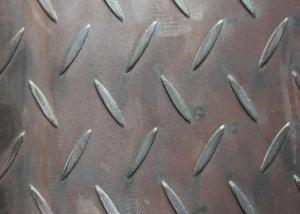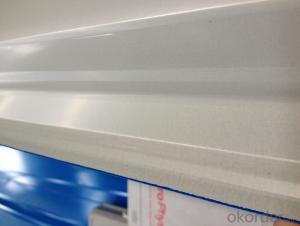Corrugated Hot Dipped Galvanized Steel-Sheet
- Loading Port:
- Shanghai
- Payment Terms:
- TT OR LC
- Min Order Qty:
- 50 m.t.
- Supply Capability:
- 2000 m.t./month
OKorder Service Pledge
OKorder Financial Service
You Might Also Like
Description:
Corrugated sheet is a high strength and durable steel, mostly used for architectural decoration. We have scores of corrugated sheets production lines of different types, producing profiled sheets of all kinds of types and colors. Since it adopts high strength steel sheet and the dimension is designed reasonably, the corrugated sheets are widely used on roofs and walls of various buildings, which can be easily installed, be flexible and changeable, unrestricted by no factor of the buildings.
Pressing steel panel can be freely incised, it can satisfy the especially designing demands. It apply on convenient construction, and anti-seismic performance, fire proof, waterproof, .
Base sheet : galvanized steel sheet, pre painted galvanized steel sheet

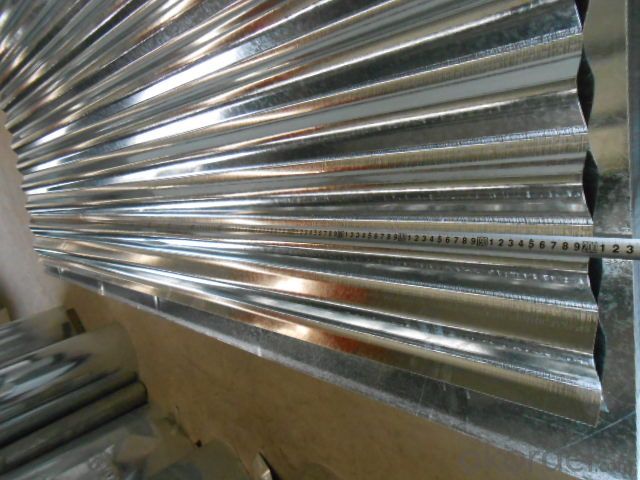
Application:
It has been widely applied on civil construction like storerooms, special building roof and walls of wide-span steel structure building and so on.
Pressing steel panel with the clear line, and many colors for choice, suitable for any different building style materials, achieving satisfy effects;
Product Specification:
Thickness tolerance: (+/-0.01mm)
Zinc coating: 50-180g/m2
Standard:jis g 3302, SGCH
Package: 3 ton/pallet
Specs: 0.14-0.8mm x 900mm x 2000mm
Width:700-1250mm(900mm,1215mm,1250mm,1000mm the most common)
Surface:regular/mini/zero spangle, chromated, skin pass, dry etc.
Package:Standard seaworthy export packing
FAQ:
1. Do you have pallets for the package?
Yes, we must use pallets for the package in order to load.
2.How many pieces for one package?
The pieces for one tone is decided by the thickness of the sheet, but we can make it according to your requirements in the reasonable range.
3. Could you produce the sheets according to our design?
Yes, we can make it.
- Q: What is the difference between a hot rolled and hot dipped galvanized steel sheet?
- The main difference between a hot rolled and hot dipped galvanized steel sheet is the process they undergo. Hot rolled steel sheets are produced by heating the steel above its recrystallization temperature and then rolling it to the desired thickness. On the other hand, hot dipped galvanized steel sheets are formed by immersing the steel sheet into a bath of molten zinc, creating a layer of zinc coating on the surface. This zinc coating provides excellent corrosion resistance to the steel, making it suitable for applications where protection against rust is important.
- Q: Are steel sheets suitable for data center infrastructure?
- Yes, steel sheets are suitable for data center infrastructure. Steel sheets are often used in the construction of data centers due to their strength, durability, and fire-resistant properties. They provide structural support for the infrastructure, including server racks, cabinets, and raised flooring systems. Steel sheets also help protect the data center equipment from potential hazards like electromagnetic interference (EMI) and physical damage. Additionally, steel sheets can be easily customized and configured to meet the specific requirements of a data center, making them a popular choice for infrastructure construction.
- Q: Can steel sheets be used for clamps or fasteners?
- Yes, steel sheets can be used for clamps or fasteners. Steel sheets can be fabricated into various shapes and sizes, making them suitable for creating clamps or fasteners that provide secure and sturdy connections.
- Q: Can steel sheets be used for bridge construction or infrastructure projects?
- Yes, steel sheets can be used for bridge construction or infrastructure projects. Steel is a popular choice for these applications due to its exceptional strength, durability, and versatility. Steel sheets can be used in various forms, such as hot-rolled, cold-rolled, or galvanized, depending on the specific requirements of the project. Steel sheets offer several advantages for bridge construction and infrastructure projects. Firstly, they have a high load-bearing capacity, making them suitable for supporting heavy loads and ensuring the structural integrity of bridges and infrastructure. Steel also has a high tensile strength, which allows it to withstand high levels of stress and deformation without failure. Additionally, steel sheets can be easily fabricated into various shapes and sizes, allowing for flexible design options. This flexibility allows engineers to create innovative and efficient structures that meet specific project requirements. Steel is also highly recyclable, making it an environmentally friendly choice for sustainable infrastructure projects. Moreover, steel sheets have excellent resistance to corrosion, which is crucial for infrastructure projects exposed to harsh environmental conditions, such as bridges located near saltwater or industrial areas. The use of galvanized steel sheets can further enhance their resistance to corrosion, ensuring long-term durability and reduced maintenance requirements. Overall, steel sheets are a reliable and widely used material for bridge construction and infrastructure projects. Their strength, durability, flexibility, and resistance to corrosion make them an ideal choice for ensuring the safety and longevity of these critical structures.
- Q: How do steel sheets compare to other materials, such as aluminum or copper?
- There are several advantages to using steel sheets instead of materials like aluminum or copper. Firstly, steel is known for its exceptional strength and durability, making it able to withstand heavy loads and resist impacts better than aluminum or copper. This makes steel sheets perfect for applications that require high strength and structural integrity, such as in construction or the automotive industry. Furthermore, steel sheets have a higher melting point than aluminum or copper, meaning they can withstand higher temperatures without deforming or melting. This makes steel sheets suitable for applications that involve exposure to high temperatures, like in manufacturing processes or engine components. Additionally, steel sheets have excellent corrosion resistance properties. They can be coated with protective layers like zinc or chromium to enhance their resistance to rust and corrosion. In contrast, aluminum and copper are more prone to corrosion, especially when exposed to certain environments or chemicals. This makes steel sheets the preferred choice for outdoor applications or structures that need long-term durability. Another advantage of steel sheets is their cost-effectiveness. Steel is relatively cheaper compared to aluminum or copper, especially when considering its strength and durability. This makes steel sheets a more economical choice for various applications where cost is an important factor. However, it is important to note that aluminum and copper also have their own advantages. Aluminum is lightweight and has excellent thermal conductivity, making it suitable for applications that require lightweight materials or efficient heat transfer. Copper, on the other hand, has superior electrical conductivity, making it ideal for electrical wiring or components. In conclusion, steel sheets offer exceptional strength, durability, corrosion resistance, and cost-effectiveness compared to aluminum or copper. However, the choice of material ultimately depends on the specific requirements of the application, such as weight, thermal or electrical conductivity, and environmental factors.
- Q: Can steel sheets be used for outdoor sculptures?
- Yes, steel sheets can be used for outdoor sculptures. Steel is a durable and weather-resistant material, making it suitable for withstanding outdoor elements. Additionally, steel sheets can be easily manipulated and shaped to create various forms and designs, making them a popular choice for outdoor sculpture projects.
- Q: How do steel sheets perform in terms of energy efficiency?
- Steel sheets have good energy efficiency properties due to their high thermal conductivity, which allows for efficient heat transfer. Additionally, steel sheets can be coated with insulating materials to further enhance their energy efficiency.
- Q: What are the different testing methods for steel sheets?
- There are several testing methods for steel sheets, including visual inspection, hardness testing, tensile testing, impact testing, bend testing, and ultrasonic testing. Visual inspection involves examining the surface for any visible defects or imperfections. Hardness testing measures the resistance of the steel to indentation, which can indicate its strength and durability. Tensile testing evaluates the steel's ability to withstand pulling forces, while impact testing measures its resistance to sudden shocks or impacts. Bend testing assesses the steel's flexibility and ability to withstand deformation. Ultrasonic testing uses sound waves to detect internal flaws or defects in the steel. These methods are commonly used to ensure the quality and reliability of steel sheets in various industries.
- Q: Are steel sheets resistant to corrosion?
- Yes, steel sheets are resistant to corrosion due to their high iron content, which forms a protective oxide layer on the surface, preventing rust and other forms of corrosion.
- Q: What are the different packaging options available for steel sheets?
- There are various packaging options available for steel sheets, depending on their size, shape, and intended use. Some common packaging options include: 1. Wooden crates: Steel sheets are often packed in wooden crates, which provide sturdy protection and prevent damage during transportation. The sheets are secured inside the crate using straps or bands to ensure they remain in place. 2. Steel frames: Another option is to package steel sheets in steel frames. This method provides extra protection and stability, especially for larger or heavier steel sheets. The frame is designed to securely hold the sheets in place and prevent any shifting during transit. 3. Coil packaging: Steel sheets that are in the form of coils are often packaged differently. They can be wrapped in plastic or paper to protect them from moisture, dust, and other environmental factors. The coils are then typically placed on pallets to facilitate easy handling and transportation. 4. Bundles: Steel sheets can also be bundled together using steel straps or bands. This packaging method is commonly used for smaller sheets or when multiple sheets need to be packaged together. The bundles can be further secured with shrink wrap or plastic covers to ensure they stay intact during shipping. 5. Custom packaging: Depending on specific requirements or customer preferences, steel sheets can be packaged in custom-designed packaging. This can include using foam padding or inserts to protect delicate or sensitive surfaces, or using specialized containers for specific applications such as food-grade steel sheets. Overall, the packaging options for steel sheets are diverse and can be tailored to meet the needs of different industries and customers. The choice of packaging will depend on factors such as sheet size, weight, level of protection required, and transportation method.
Send your message to us
Corrugated Hot Dipped Galvanized Steel-Sheet
- Loading Port:
- Shanghai
- Payment Terms:
- TT OR LC
- Min Order Qty:
- 50 m.t.
- Supply Capability:
- 2000 m.t./month
OKorder Service Pledge
OKorder Financial Service
Similar products
Hot products
Hot Searches
Related keywords
